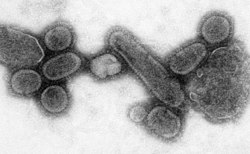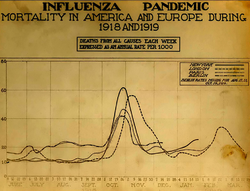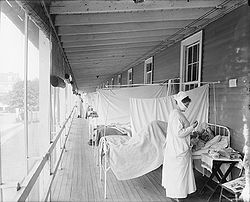Medical diagnosis for the student and practitioner (1922) (14598070568)
X-ray of hemorrhagic pneumonitis as seen in the 1918 influenza strain
Identifier: medicaldiagnosi00gree (find matches)
Title: Medical diagnosis for the student and practitioner
Year: 1922 (1920s)
Authors: Greene, Charles Lyman, 1862-
Subjects: Diagnosis
Publisher: Philadelphia, Blakiston
Contributing Library: The Library of Congress
Digitizing Sponsor: The Library of Congress
View Book Page: Book Viewer
About This Book: Catalog Entry
View All Images: All Images From Book
Click here to view book online to see this illustration in context in a browseable online version of this book.
Text Appearing Before Image:
in a large proportion of the cases in the left lung.Resolution, when it appeared, was usually relatively slow, termination bycrisis being the exception rather than the rule. Roentgenographic Findings.—As an interesting incident of his Warservice the author was privileged to see a portion of the radiographic work INFLUENZA I02 done by Major John Hunter Selby, Chief of the Roentgen Ray Section,Walter Reed Hospital, in cases of influenzal hemorrhagic pneumonitis. The X-ray pictures were so clarifying with respect to the beginnings andextension of the pneumonic process and so great a degree of accuracy inprognosis was shown by Major Selby that he feels that a brief considerationof this investigators findings should be included in this article. In all 470 patients were referred and of these 386 were found to be suffer-ing from hemorrhagic pneumonitis. So far as possible all cases were sub-mitted daily to radiographic examination by means of the ward unit madeavailable in army hospitals.
Text Appearing After Image:
Fig. 491.—The initial film reveals the presence of hemorrhagic pneumonitis in theadjacent portions of the upper and lower left lobes and also in the adjacent portions of thelower and middle right lobes. Note that the density is most intense at the hilum andfades out toward the periphery. Note the clearness of the costophrenic angles on theright and left sides. The following quotation is taken from Selbys article in the AmericanJournal of Roentgenology.* Mode of Onset.—Hemorrhagic pneumonitis usually began coincidentlywith, or soon after, the incidence of a secondary rise in temperature,! occur-ring from one to five days after the patient had run what was apparently atypical influenza course. Less frequently it appeared on the fourth or fifth * American Journal of Roentgenology, 1919, Vol. 6, page 211. t This observation was noted early in the epidemic by Lieut. J. Harkavy andpersonally communicated to me. This enabled us to detect a larger number of earlycases than otherwise would
Note About Images
Relevante Bilder
Relevante Artikel
Spanische GrippeDie Spanische Grippe war eine Influenza-Pandemie, die durch einen ungewöhnlich virulenten Abkömmling des Influenzavirus verursacht wurde und sich zwischen 1918 – gegen Ende des Ersten Weltkriegs – und 1920 in drei Wellen verbreitete und bei einer Weltbevölkerung von etwa 1,8 Milliarden laut WHO zwischen 20 Millionen und 50 Millionen Menschenleben forderte, Schätzungen reichen bis zu 100 Millionen. Damit starben an der Spanischen Grippe mehr Menschen als im Ersten Weltkrieg durch Kriegshandlungen. Insgesamt sollen etwa 500 Millionen Menschen infiziert worden sein, was eine Letalität von 5 bis 10 Prozent ergibt, die damit deutlich höher lag als bei Erkrankungen durch andere Influenza-Erreger. .. weiterlesen
























